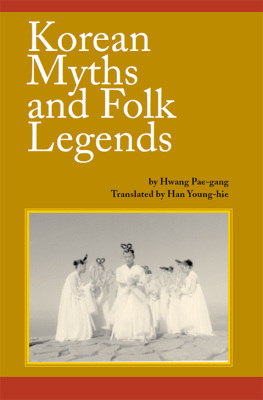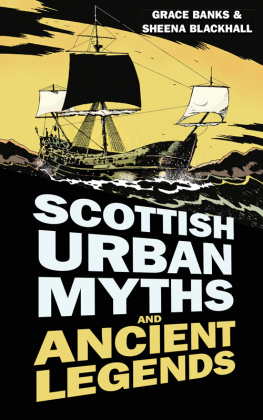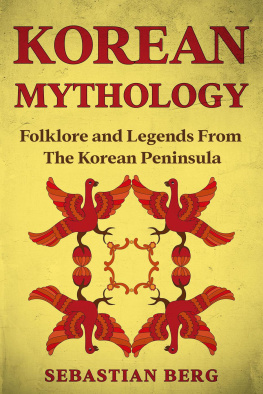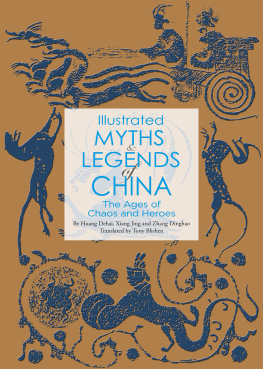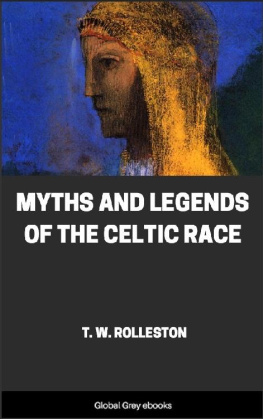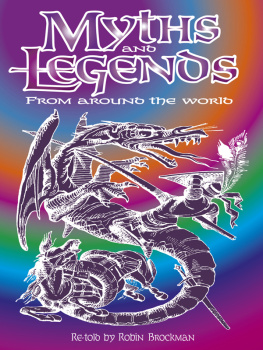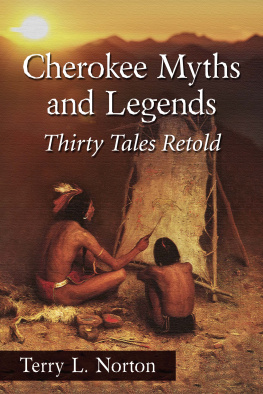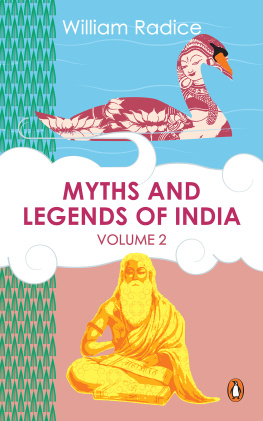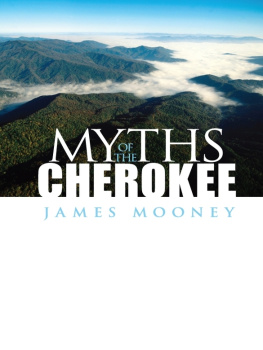Table of Contents

Korean Myths and Folk Legends
Korean Myths
and
Folk Legends
by
Pae-Gang HWANG
Translated by
Young-Hie HAN,
Se-Joong KIM,
and
Seung-Pyong CHWAE

JAIN PUBLISHING COMPANY
Fremont, California
jainpub.com
Jain Publishing Company, Inc. is a diversified publisher of college textbooks and supplements, as well as professional and scholarly references, and books for the general reader. A complete, up-todate listing of all the books, with cover images, descriptions, review excerpts, specifications and prices is always available on-line at jainpub.com. Our booksPLUS division provides custom publishing and related services in print as well as electronic formats, and our learn24x7 division offers electronic course and training materials development services.
Acknowledgment is made to Korea Literature Translation Institute (LTI Korea) for financial assistance in the production of this book.
Copyright 2006 by Pae-Gang HWANG. All rights reserved. No part of this book may be reproduced, stored in a retrieval system, or transmitted, in any form or by any means, electronic, mechanical, photocopying, recording or otherwise, without the written permission of the publisher except for brief passages quoted in a review.
Contents
As the anthropologist, William Bright, once observed, The different worlds of different peoples have different shapes. Myth is one of the most authentic expressions of just that difference, and with the publication of this English edition of Korean Myths, both the scholar and the general reader are granted new access to the rich and ancient traditions of Korea.
Myths afford an insight into the world of the believer and, as such, convey a truth that is more akin to that of a caricature than that of a photograph. Details are exaggerated in order to emphasize a value and it remains the task of both scholar and general reader, each to their level of interest, to recognize that insight. That this truth is encased in the narrative form resonates with the reader, more precisely the listener, in a manner that is as perennial as the insight itself.
The genesis story of this English edition would recount a first meeting with Professor Hwang in his office at Dankook University, Cheonan Campus, in 1994. Knowing of my professional interest in myth, Professor Hwang presented me with a Korean edition of this book. After remarking that, to my knowledge, such material was still relatively scarce in English, we discussed this project. That this work is now available is a testament to his foresight and persistence.
Stephen J. Reno
Chancellor, University System of New Hampshire, Durham
This book is an English translation of Myths of Korea which was published by the Dankook University Press, Seoul, Korea, in 1988. The original work was a revised separate edition of Korean Mythology, the fourth in the World Myths Series composed of five volumes which were issued by the Taijong Publishing Company in 1973.
In retrospect, the old stories that the author was told by his maternal grandmother, while pillowing his head on her lap half asleep and half awake, were the mental pabulum which fostered the imagination of a childs mind and enabled him to live in a dream world. Even at an age approaching seventy, I still find myself full of nostalgia for the good old days especially in the face of todays human alienation. Thanks to my maternal grandmothers sweet old stories, I was, at a tender age, able to have an opportunity to gain access to the rich ethnic sentiments imparted by numerous unknown folk storytellers and cultivate my love for nature and humans in my own naive way. Viewed from a critical perspective, such tales could be simply ignored or relegated to puerile stories which were told by an uneducated old woman catering to the fancy of mere children, since the story lines were not so sophisticated and sometimes incoherent.
Such a drawback, however, is inevitable in view of the fact that those stories had been stretched, embellished, and altered in the course of being handed down orally by numerous storytellers over a long period of time. Quite simply, they are a product of the concerted efforts of the masses which has stood the test of time. Therefore, various characteristics of different ages are colorfully preserved and amalgamated in such stories, which are a precious legacy of mankind passed on from generation to generation. The lives and sentiments of the various people of ancient times can excite nostalgia for bygone days of which the moderns may otherwise be completely oblivious. The vivid meanings imparted by the myths and legends of the past which have survived and been tenaciously carried on in the minds of the masses reflect the values of the present that the people of today should strive to restore. For all the polemics over the logicality of a myth, the claim that the folklore of a specific ethnic group does not stand to reason is irrelevant to its true nature and a lean-to-one-side literary criticism.
The myths and legends collected in the book are part of the national tradition passed down by word of mouth over a period of several thousand years by the people on the Korean Peninsula where the author was born and brought up. Since most Koreans are familiar with the folk stories contained in the book, there are lots of conflicting opinions and divergent views on the interpretation of a myth as there are so many men, so many minds. This volume also includes several pieces of the documented narrative literature which were put on record at a certain point in the past based on stories orally handed down by nameless storytellers.
In addition to several old documents, a few oral narratives are incorporated into the text of this book. Most documented pieces are taken from Samguk Yusa (Legends of the Three Kingdoms), the high-water mark of Korean narrative literature, and some are selected from a wide variety of source materials such as Samguk Sagi (History of the Three Kingdoms), other written accounts of history, and the historical geographies of various regions. Reference to the documented or oral source materials for each story is made at the end of each piece.
Princess Bari, originally a shamanistic myth in a verse form, was reconstructed on the basis of four different versions of a shaman ballad and rewritten in prose. As a result, there are some contextual disparities inherent in the original sources. Although care was taken to keep intact the original form of a myth and avoid too much use of rhetorical flourishes, there is no doubt that there is still room for further improvement. Rather than adhering too closely to the original wording in the text, the author paid attention to its overall contextual framework and the communication of its original purport, and did not shy away from unobtrusively incorporating his own personal opinions into the story. Because of it, the author is afraid and on his guard that he might be reduced to the enemy of mythology expounded by Lu Hsun, a Chinese literary researcher. It may be a natural consequence of the excessive enthusiasm of the author who envied and desired to emulate the precedent set by Yi Kyu-Bo, a member of the Kory literati, who succeeded in reciting the myth of King Tongmyng in verse. The author should leave the matter entirely to the final judgment of the reader.
There are lots of difficulties attendant on translating the Korean text into English. The lack of one-to-one correspondence between the two languages in portraying ancient customs, manners, or rituals makes it almost impossible to translate in the true sense of the term. I should like to acknowledge with thanks the arduous translation work of Professor Young-Hie HAN, Professor Se-Joong KIM, and Lecturer Seung-Pyong CHWAE, and thank Professor Paul LUCHESSA and Professor Bill RYAN for their proofreading, and Mr. Min-Song SUNG and Ms. Jee-Yeon CHOI, for their keying the text with religious care. I also should like to take this occasion to express my sincere appreciation to Dr. Hong-No YOON, the former president of Dankook University, who inspired me to undertake the translation work and supported me in publishing this book, Dr. Stephen J. RENO, the President of Southern Oregon University, who spared no words of encouragement and as a mythologist, showed keen interest in the translation of the original work, and Dr. Choong-Sik CHANG, the Chairman of the Board of Trustees of Dankook University, who provided material and moral support for the publication of the book.

